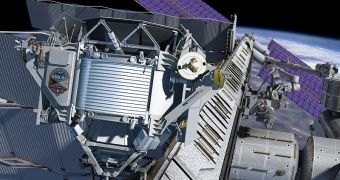Currently planned for July 29, the STS-134 mission is to be the last flight of space shuttle Endeavor. It is planned to carry two important additions to the International Space Station (ISS), the third ExPRESS Logistics Carrier, and the largest particle detector flown in space, the Alpha Magnetic Spectrometer (AMS). But recent tests have revealed that the superconducting magnet at the core of the seven-ton machine is behaving unexpectedly, which means that it needs to be replaced with a conventional permanent magnet, Nature News reports.
This is the same kind of device the AMS was originally designed and tested to work with, but astrophysicists had hoped to be able to use the superconducting variety so as to boost the sensitivity of the instrument. The spectrometer, one of the most complex devices flown to space, will be affixed to a special berth aboard the ISS, where it will conduct measurements on the properties of cosmic rays. Scientists hope that this will allow them to gain more insight on the nature of dark matter, the elusive stuff that is only visible through its gravitational pull, and is also believed to make up the largest portion of all matter in the Universe.
The AMS was first tested about two months ago at the Large Hadron Collider (LHC), near Geneva, Switzerland, and then later at the European Space Agency's (ESA) European Space Research and Technology Center (ESTEC), in Noordwijk, the Netherlands. Engineers noticed a worrying behavior in the spectrometer, and namely the fact that it heated excessively during operations. This is a major issue given that the entire instrument was supposed to work at just 1.8 degrees above absolute zero. The new data suggested that the entire system would need about 40 percent more liquid helium coolant than originally estimated.
Redesigning the instrument is unfeasible in such a short time frame, and the alternative would have been to keep it operational for less than two years, as opposed to the initially-planned four years. “The AMS is by far and away the most important science currently planned for the space station,” explains particle theorist John Ellis, who is based at the European Organization for Nuclear Research (CERN). The issue with replacing the magnet is that the new one will have a lower momentum resolution, which means that its abilities to identify various types of particles will be lower than its predecessor's. But experts hope that the longer run time will eventually compensate for this drawback.

 14 DAY TRIAL //
14 DAY TRIAL //